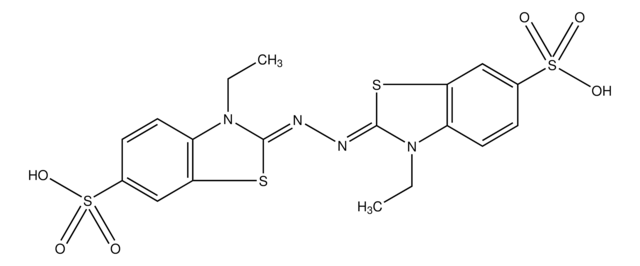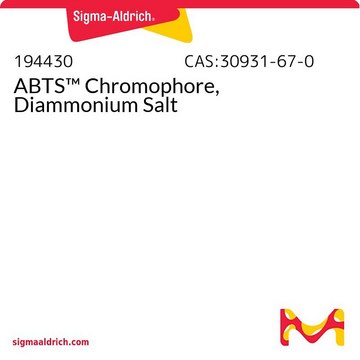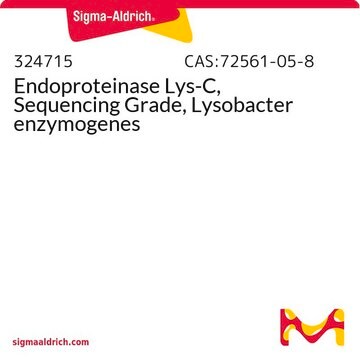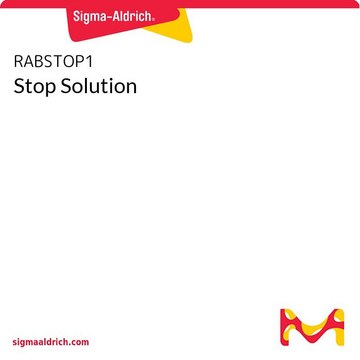Alle Fotos(1)
Wichtige Dokumente
11204530001
Roche
ABTS™ Buffer
solution, pkg of 125 mL
Synonym(e):
buffer
Anmeldenzur Ansicht organisationsspezifischer und vertraglich vereinbarter Preise
Alle Fotos(1)
About This Item
UNSPSC-Code:
12352204
Empfohlene Produkte
Form
solution
Qualitätsniveau
Verpackung
pkg of 125 mL
Hersteller/Markenname
Roche
Versandbedingung
wet ice
Lagertemp.
2-8°C
Allgemeine Beschreibung
2,2′-azino-di-(3-ethylbenzthiazoline sulfonic acid) or ABTS acts as a substrate for HRP (horseradish peroxidase) conjugate during enzyme-linked immunosorbent assay (ELISA). It is the most sensitive, and stable substrate when compared to three other substrates namely, 5-aminosalicylic acid (5AS), O-phenylenediamine (OPD), O-tolidine (OT). It also produces the best visual results, where it gives a bluish-green color. ELISA using ABTS is a highly sensitive, specific and reproducible technique.
Anwendung
ABTS Buffer is a solvent for ABTS. ABTS solution is the ideal substrate solution for enzyme immunoassays with horseradish peroxidase (HRP) as a marker enzyme. Because of the high sensitivity of the reaction, autoreaders will often display "over" after several minutes.
Angaben zur Herstellung
Working concentration: Flow cytometry: 0.5 μg/100 μl (106 cells); Immunohistocytochemistry: 50 μg/ml
Working concentration of conjugate depends on application and substrate. Concentrations should be taken as a guideline.
Working solution: Dissolve one ABTS tablet (5 mg) in 5 ml of ABTS buffer. This solution has a light-green color. In microtiter plates, the solution is colorless A405 nm/1 cm should be <0.16. Work as clean as possible. Heavy metal ions or traces of peroxidase can produce a dark green ABTS solution. Such solutions are not suitable for the assay.
Working concentration of conjugate depends on application and substrate. Concentrations should be taken as a guideline.
Working solution: Dissolve one ABTS tablet (5 mg) in 5 ml of ABTS buffer. This solution has a light-green color. In microtiter plates, the solution is colorless A405 nm/1 cm should be <0.16. Work as clean as possible. Heavy metal ions or traces of peroxidase can produce a dark green ABTS solution. Such solutions are not suitable for the assay.
Sonstige Hinweise
For life science research only. Not for use in diagnostic procedures.
Rechtliche Hinweise
ABTS is a trademark of Roche
WGK
nwg
Flammpunkt (°F)
No data available
Flammpunkt (°C)
No data available
Analysenzertifikate (COA)
Suchen Sie nach Analysenzertifikate (COA), indem Sie die Lot-/Chargennummer des Produkts eingeben. Lot- und Chargennummern sind auf dem Produktetikett hinter den Wörtern ‘Lot’ oder ‘Batch’ (Lot oder Charge) zu finden.
Besitzen Sie dieses Produkt bereits?
In der Dokumentenbibliothek finden Sie die Dokumentation zu den Produkten, die Sie kürzlich erworben haben.
Kunden haben sich ebenfalls angesehen
C Lindenthal et al.
Infection and immunity, 69(1), 52-57 (2000-12-19)
Enterotoxigenic Escherichia coli (ETEC) is capable of invading epithelial cell lines derived from the human ileum and colon. Two separate invasion loci (tia and tib) that direct noninvasive E. coli strains to adhere to and invade cultured human intestine epithelial
Patrik Erlmann et al.
Molecular biology of the cell, 20(20), 4400-4411 (2009-08-28)
Deleted in Liver Cancer 1 (DLC1) is a GTPase-activating protein (GAP) with specificity for RhoA, RhoB, and RhoC that is frequently deleted in various tumor types. By inactivating these small GTPases, DLC1 controls actin cytoskeletal remodeling and biological processes such
H Matsuda et al.
The Japanese journal of experimental medicine, 54(3), 131-138 (1984-06-01)
A micro-technique of enzyme-linked immunosorbent assay (ELISA) using ABTS, 2,2'-azino-di-(3-ethylbenzthiazoline sulfonic acid), as a substrate for horseradish peroxidase (HRP) conjugate was studied. In a comparative study among 4 substrates, namely; 5-aminosalicylic acid (5AS), O-phenylenediamine (OPD), O-tolidine (OT) and ABTS, for
Bruce S Sachais et al.
Blood, 120(5), 1137-1142 (2012-05-12)
Rapid laboratory assessment of heparin-induced thrombocytopenia (HIT) is important for disease recognition and management. The utility of contemporary immunoassays to detect antiplatelet factor 4 (PF4)/heparin antibodies is hindered by detection of antibodies unassociated with disease. To begin to distinguish properties
Unser Team von Wissenschaftlern verfügt über Erfahrung in allen Forschungsbereichen einschließlich Life Science, Materialwissenschaften, chemischer Synthese, Chromatographie, Analytik und vielen mehr..
Setzen Sie sich mit dem technischen Dienst in Verbindung.












